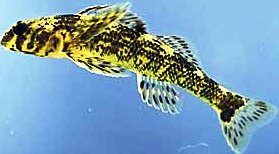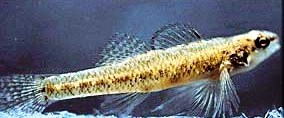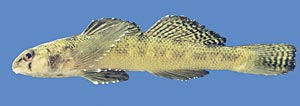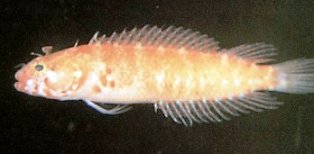Discover Florida Nature
It's time to explore the natural Florida


|
|
|
|
|
 Key
Silverside (Menidia conchorum) Threatened- The key silverside
fish is only found in the Florida keys in Florida, from Key West north
to Long Key. A small fish, the key silverside is less than two inches
long and is silver with a dark line along it's middle. It is the
smallest known species of Menidia. The main habitat for the key
silverside fish is in shallow mangroves where there is a high density of
vegetation. Habitat destruction for development has reduced available
habitats through loss of a number of ponds and formerly occupied sites.
In addition to the native importance of the key silverside, it is also a
main food source for many predatory fish in Lake Waccamaw. Key
Silverside (Menidia conchorum) Threatened- The key silverside
fish is only found in the Florida keys in Florida, from Key West north
to Long Key. A small fish, the key silverside is less than two inches
long and is silver with a dark line along it's middle. It is the
smallest known species of Menidia. The main habitat for the key
silverside fish is in shallow mangroves where there is a high density of
vegetation. Habitat destruction for development has reduced available
habitats through loss of a number of ponds and formerly occupied sites.
In addition to the native importance of the key silverside, it is also a
main food source for many predatory fish in Lake Waccamaw. Crystal
Darter (Crystallaria asprella ) Threatened- Originally crystal
darters existed in the Mississippi River basin from Ohio to Minnesota
and south to southern Mississippi, northern Louisiana, southeastern
Oklahoma and the Gulf Slope in Escambia, Mobile Bay and Pearl River
drainages. However, it is now extinct in Ohio, Kentucky, Indiana and
Illinois. The crystal darter can grow to 5 inches in length. It is
olive-colored to tan with four dark saddles extending downward to its
lateral line, a brownish stripe, and a whitish belly. It's maximum
reported age is 3 years. The crystal darter prefers sand and gravel bars
in large flowing rivers and streams of the Coastal Plain. It has the
interesting habit of burying itself in the sand, leaving only its eyes
above exposed; this is presumably to minimize body movement, thus
conserving energy, and to maintain its position in the swift waters of
its preferred habitats. Most individuals remain in deep water during the
day and move to shallow sand and gravel bars at dusk to search for
aquatic insects. Spawning begins in late February. Crystal
Darter (Crystallaria asprella ) Threatened- Originally crystal
darters existed in the Mississippi River basin from Ohio to Minnesota
and south to southern Mississippi, northern Louisiana, southeastern
Oklahoma and the Gulf Slope in Escambia, Mobile Bay and Pearl River
drainages. However, it is now extinct in Ohio, Kentucky, Indiana and
Illinois. The crystal darter can grow to 5 inches in length. It is
olive-colored to tan with four dark saddles extending downward to its
lateral line, a brownish stripe, and a whitish belly. It's maximum
reported age is 3 years. The crystal darter prefers sand and gravel bars
in large flowing rivers and streams of the Coastal Plain. It has the
interesting habit of burying itself in the sand, leaving only its eyes
above exposed; this is presumably to minimize body movement, thus
conserving energy, and to maintain its position in the swift waters of
its preferred habitats. Most individuals remain in deep water during the
day and move to shallow sand and gravel bars at dusk to search for
aquatic insects. Spawning begins in late February. Harlequin
Darter (Etheostoma histrio) SSC- Originally found in the much
of Mississippi River drainage area from Kentucky to Louisiana, and from
Escambia River in Florida to Neches River in Texas. Harlequin darters
inhabit sand and gravel runs of small to medium rivers, usually near
snags in swift moving water. The harlequin darter is distinguished by
two large, tan to dark brown blotches near the caudal fin base and
several large, dark spots on the side and ventral surface of the head
and body. Harlequin darters frequent a variety of habitats, including
upland streams with gravel and rubble riffles with swift flow and in
lowland streams over sand in brush, debris, and log snags with moderate
to swift current Harlequin
Darter (Etheostoma histrio) SSC- Originally found in the much
of Mississippi River drainage area from Kentucky to Louisiana, and from
Escambia River in Florida to Neches River in Texas. Harlequin darters
inhabit sand and gravel runs of small to medium rivers, usually near
snags in swift moving water. The harlequin darter is distinguished by
two large, tan to dark brown blotches near the caudal fin base and
several large, dark spots on the side and ventral surface of the head
and body. Harlequin darters frequent a variety of habitats, including
upland streams with gravel and rubble riffles with swift flow and in
lowland streams over sand in brush, debris, and log snags with moderate
to swift current Okaloosa
Darter (Etheostoma okalossae) Endangered- Darters are
characterized by the two fan like dorsal fins and the Okaloosa darter
reaches scarcely 2 inches in length. They are found only in the
Choctawhatchee Bay drainage in Florida, where they inhabit vegetated
sand runs of clear creeks. The species specific population is currently
unknown (estimated between 1,500 to 10,000). The Okaloosa darter is very
likely to be displaced in its entire range by the brown darter. Efforts
at Eglin Air Force Base to revive the darter’s dwindling population have
been successful. The U.S. Fish & Wildlife Service, as part of a recent
status review, has recommended that the 1-to-2-inch fish with big eyes
be down listed from endangered to threatened. Okaloosa
Darter (Etheostoma okalossae) Endangered- Darters are
characterized by the two fan like dorsal fins and the Okaloosa darter
reaches scarcely 2 inches in length. They are found only in the
Choctawhatchee Bay drainage in Florida, where they inhabit vegetated
sand runs of clear creeks. The species specific population is currently
unknown (estimated between 1,500 to 10,000). The Okaloosa darter is very
likely to be displaced in its entire range by the brown darter. Efforts
at Eglin Air Force Base to revive the darter’s dwindling population have
been successful. The U.S. Fish & Wildlife Service, as part of a recent
status review, has recommended that the 1-to-2-inch fish with big eyes
be down listed from endangered to threatened. Southern
Tessellated Darter (Etheostoma olmstedi) SSC- A member of the
perch families these fish are generally less than 4.0 to 4.5 inches and
found near the bottom of sandy and muddy pools of headwaters, creeks and
small to medium rivers; and shores of lakes. In nature, the tessellated
darter feeds on benthic invertebrates, primarily midge larvae
(Chironomidae-Tendipedidae) but other organisms, such as amphipods,
mayfly nymphs, cladocera and copepods, are taken in smaller amounts.
Tessellated darters prefer sandy substrates on moderate to slow-flowing
water. They can be collected in sandy lakes on occasion. Southern
Tessellated Darter (Etheostoma olmstedi) SSC- A member of the
perch families these fish are generally less than 4.0 to 4.5 inches and
found near the bottom of sandy and muddy pools of headwaters, creeks and
small to medium rivers; and shores of lakes. In nature, the tessellated
darter feeds on benthic invertebrates, primarily midge larvae
(Chironomidae-Tendipedidae) but other organisms, such as amphipods,
mayfly nymphs, cladocera and copepods, are taken in smaller amounts.
Tessellated darters prefer sandy substrates on moderate to slow-flowing
water. They can be collected in sandy lakes on occasion.  Key
Blenny (Starksia starcki) SSC- A small fish, the key Blenny
ranges from .8 to 1.1 inches long. Little is known about the habitat of
the key blenny but it has been collected in surge channels between rows
of corals in water less than 25 feet deep. The key blenny fish is only
found off the Florida Keys, south of Big Pine Key. This fish has a
pattern of brown bars broken up by a horizontal line with tan
interspaces. The blenny fish are characterized among Gulf of Maine
fishes by the position of their ventral fins, which are under or in
front of the pectorals, combined with a single dorsal fin that is spiny
throughout its length and extends the whole length of the trunk, and
with a slender form, eel-like in some of them. These fish are often
found in aquariums. Key
Blenny (Starksia starcki) SSC- A small fish, the key Blenny
ranges from .8 to 1.1 inches long. Little is known about the habitat of
the key blenny but it has been collected in surge channels between rows
of corals in water less than 25 feet deep. The key blenny fish is only
found off the Florida Keys, south of Big Pine Key. This fish has a
pattern of brown bars broken up by a horizontal line with tan
interspaces. The blenny fish are characterized among Gulf of Maine
fishes by the position of their ventral fins, which are under or in
front of the pectorals, combined with a single dorsal fin that is spiny
throughout its length and extends the whole length of the trunk, and
with a slender form, eel-like in some of them. These fish are often
found in aquariums.
|
|
|
Advertise | Privacy Statement | Dog Encyclopedia | Video |Contact | Alaska Nature |
|